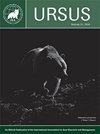马来熊正在捕食东方斑犀鸟的巢穴
IF 0.6
4区 生物学
Q4 ZOOLOGY
引用次数: 1
摘要
摘要马来熊(Helarctos malayanus)是一种以水果和无脊椎动物为食的机会主义杂食性动物,但其捕食行为很少被记录。虽然通常被描述为依赖森林的物种,但马来熊是一个多面手,似乎有一些适应不断变化的环境的潜力。在这里,我们报告了马来熊在2019年春天在马来西亚婆罗洲沙巴的下基纳巴丹干野生动物保护区的巢穴中捕食东方斑犀鸟(Anthracoceros albirostris)的第一个记录。这是一片被油棕(Elaeis guineensis)种植园包围的人为干扰的景观,剩余的退化森林为婆罗洲的野生动物提供了一条野生动物走廊。在野生动物走廊上被相机捕捉到的马来熊,包括掠食性熊,看起来状况良好,因此显然找到了足够的食物资源。它们的机会主义进食行为,不一定是食物短缺,可能会让它们捕食脆弱的猎物,比如这只筑巢较低的犀鸟。本文章由计算机程序翻译,如有差异,请以英文原文为准。
Sun bear predation on an oriental pied hornbill nest
Abstract: Sun bears (Helarctos malayanus) are opportunistic omnivores that feed predominantly on fruits and invertebrates, but predatory behavior by sun bears is rarely recorded. Although commonly described as a forest-dependent species, the sun bear is a generalist and seems to have some potential to adapt to changing environments. Here we report the first record of a sun bear predating on oriental pied hornbills (Anthracoceros albirostris) in their nest in the Lower Kinabatangan Wildlife Sanctuary in Sabah, Malaysian Borneo, during spring of 2019. It is a human-disturbed landscape surrounded by oil palm (Elaeis guineensis) plantations, with the remaining degraded forest providing a wildlife corridor for Borneo's wildlife. The sun bears photographed by camera traps along the wildlife corridor, including the predatory bear, appeared to be in good condition, therefore evidently finding sufficient food resources. Their opportunistic feeding behavior, not necessarily food shortage, may allow them to take vulnerable prey, such as this low-nesting hornbill.
求助全文
通过发布文献求助,成功后即可免费获取论文全文。
去求助
来源期刊

Ursus
生物-动物学
CiteScore
2.00
自引率
15.40%
发文量
12
审稿时长
>12 weeks
期刊介绍:
Ursus includes a variety of articles on all aspects of bear management and research worldwide. Original manuscripts are welcome. In addition to manuscripts reporting original research, submissions may be based on thoughtful review and synthesis of previously-reported information, innovative philosophies and opinions, and public policy or legal aspects of wildlife conservation. Notes of general interest are also welcome. Invited manuscripts will be clearly identified, but will still be subject to peer review. All manuscripts must be in English. All manuscripts are peer-reviewed, and subject to rigorous editorial standards.
 求助内容:
求助内容: 应助结果提醒方式:
应助结果提醒方式:


